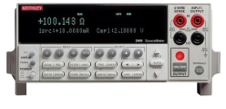Striking the Right Balance: Hardware Choices for PCB Verification
- janfessl
- Sep 4, 2023
- 3 min read
Updated: Sep 5, 2023
Introduction
Printed Circuit Board (PCB) verification is a critical phase in electronic product development. The ultimate goal is to confirm that the PCB functions according to its design specifications. The complexity of this process can vary widely, from basic continuity and voltage level checks to intricate high-speed data acquisition and real-time signal processing.
A pivotal aspect of setting up an effective test environment for PCB verification is the choice of hardware. Companies like National Instruments (NI) offer high-end, feature-rich hardware platforms that are exceptionally flexible but might be overkill for simpler projects. On the other end of the spectrum, budget-friendly alternatives may not provide the robust capabilities needed for more complex tests.
So, how do you make the right hardware choice for your PCB verification needs?

When to Choose High-End Hardware
National Instruments offers a range of modular hardware platforms like PXI, designed to excel in demanding scenarios that require high-speed data acquisition, multi-channel synchronization, real-time signal processing, and advanced control algorithms. For applications where even nanosecond delays can be catastrophic, the cost and complexity of an NI system are fully justified.

However, it's important to note that not every PCB verification task will require all these advanced capabilities. For simpler projects, like testing consumer electronics or basic industrial devices, the extensive features offered by a high-end NI system can be overkill. In such cases, the investment in NI hardware might not only be unnecessary but could also inflate the project budget without providing proportional value.
Budget-Friendly Alternatives
For simpler PCBs and budget constraints, other hardware options are available, such as:
USB Data Acquisition Devices: Suitable for basic analog and digital I/O.
Microcontrollers: Arduino or Raspberry Pi for rudimentary checks.
Standalone Test Equipment: Oscilloscopes, multimeters, and programmable power supplies for manual verification.
While these budget-friendly solutions are cost-effective, they come with limitations that could affect your project. One significant drawback is the limited number of I/O ports, which restricts the system's versatility for projects needing a higher quantity of inputs and outputs.
Furthermore, integrating different pieces of hardware often requires designing custom interfaces, adding complexity and lengthening development time. So, while initially seeming cost-effective, these options can lead to hidden costs and delays as you work to make everything function cohesively.
The Middle Road: Introducing Matrix Box
Navigating the hardware landscape between high-end and budget-friendly options, Matrix Box offers a unique middle road. Designed to integrate seamlessly with your existing test equipment, whether high-end or budget-conscious, it transforms your setup into an automated test station with minimal effort. Its internal switching system enables connectivity to hundreds of test points. Matrix Box also includes digital I/O capabilities, providing even greater control over your test setup.
Typical Usage Examples
Switching Measurement Signals: Use Matrix Box to sweep through any number of test points and measure voltage, current, and resistance values with ease. This functionality is particularly useful in quality assurance testing where various electrical parameters need to be verified across a PCB.
Distribute Power or Communication: The internal switching system can distribute power and communication channels to your test article. It allows for the simple disconnection and reconnection of any individual connection, facilitating processes like fault injection and more.
High-Number Digital I/O Control: Matrix Box is equipped to handle high-number digital I/O setups. Whether you're connecting various loads, controlling, or monitoring other peripherals in your test setup, its digital I/O capabilities make it an ideal choice for more complex control schemes.
Matrix Box offers a flexible, adaptable, and scalable platform, eliminating the need for custom interfaces and significantly reducing development time. It's a comprehensive, efficient, and cost-effective solution for PCB verification, giving you the best of both high-end and budget-friendly worlds.

Conclusion
Choosing the right hardware for PCB verification is a delicate balancing act between capabilities, scalability, and budget. While high-end systems like those offered by National Instruments provide advanced features, they can often be overkill for simpler projects. On the other end of the spectrum, budget-friendly options come with their own limitations, notably in terms of I/O capabilities and the added complexity of designing custom interfaces.
Matrix Box emerges as a compelling middle-ground solution. It brings flexibility and scalability to your test environment, allowing you to use your existing equipment and overcome many of the challenges associated with both high-end and budget options. Whether you're switching measurement signals, distributing power, or requiring digital I/O control, Matrix Box offers a comprehensive, efficient, and cost-effective way to meet your PCB verification needs.
In a world where technological demands are ever-evolving, making the right hardware choice can be the difference between a project's success and failure. Matrix Box gives you the ability to adapt and scale, ensuring that your testing capabilities are as dynamic as the projects they serve.
To learn more visit https://www.funtestfpc.com/








Comments